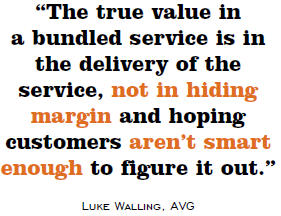Avoid The À La Carte IT Menu Trap
By The Business Solutions Network
Allowing customers free range to pick and choose which IT solutions they buy from you is almost always not in their best interests, and rarely in yours.

As an IT solutions provider, it’s important that you’re able to solve a variety of IT challenges for your customers. However, how you present your solutions can go a long way in determining your profitability. Similar to the experience of dining at a new restaurant with an overwhelming menu and getting no help selecting the appetizer, entrée, sides, and dessert, your customers can become overwhelmed by a long list of IT solutions and services from which they must choose. Even though it might seem like a nonpushy, customer-friendly thing to do, it’s ultimately going to lead to customers missing options they need, and your company falling short of its revenue potential. Learning how to sell bundled IT solutions is one way to avoid these pitfalls.
Why IT Bundles Work Better
Industry experts recognize several benefits to selling IT bundles. “One benefit is that bundles make it easier for VARs and MSPs to demonstrate the value of their solutions, which is something that always goes down well with customers — especially SMBs,” says Luke Walling, AVG VP of sales and operations. “Second, and even more important, bundled offerings allow an MSP to standardize its services.”
As resellers become more familiar with how each product interacts with others within their bundle, it creates an economy of scale for salespeople and engineers. Another benefit is that selling a bundle more naturally takes sales conversations from IT to business, which is beneficial to you and your customers. For example, if you’re selling à la carte IT products and your customer asks about your Wi-Fi router (because it’s twice as expensive as the Wi-Fi router they saw advertised in a Best Buy flyer), it’s going to lead to a lengthy conversation about packet encryption, remote management, and wireless standards. When you talk about your IT bundle, on the other hand, which they can’t get at Best Buy, it’s easier to steer the conversation toward a discussion about how you can help their business operate more efficiently, reduce downtime, protect them from external and internal threats, and maintain compliance with their industry regulations.
 “Selling bundles also makes it easier for MSPs to have deeper integration among their IT products,” says Mark Zahar, vice president of channel at Continuum. “For example, being able to manage RMM (remote monitoring and management), BDR (backup and disaster recovery), MDM (mobile device management), and security from a single platform — and to have it all integrated with the same NOC (network operation center) and helpdesk service — is invaluable.”
“Selling bundles also makes it easier for MSPs to have deeper integration among their IT products,” says Mark Zahar, vice president of channel at Continuum. “For example, being able to manage RMM (remote monitoring and management), BDR (backup and disaster recovery), MDM (mobile device management), and security from a single platform — and to have it all integrated with the same NOC (network operation center) and helpdesk service — is invaluable.”
Best Practices For Bundling Your IT Services
Two of the most difficult decisions with regard to selling bundled solutions are knowing where to begin and figuring out what to include in a bundle, and what not to include. “When creating bundled offerings, the first step is to cover your clients’ core IT requirements, including all fundamental areas of the network, such as server management, network infrastructure, and workstations,” says David Weeks, channel sales specialist, major accounts and team lead, N-able by SolarWinds. “When building out the core, you also need to have standardized practices in place internally to create consistency in delivery and pricing. The key is to ensure the productized offerings demonstrate value and yet leave the door open to customization.”
Two additional tips VARs and MSPs should follow when creating bundles include:
- Selling vertical/discipline-specific bundles. These packages comprise all the hardware, applications, and support services required to manage a particular type of business. Bundles may be named according to vertical market (e.g. healthcare, legal, retail) or discipline (e.g. accounting, HR, purchasing).
- Selling compliance or problem-resolution packages. While vertical solutions bundles may work well for new customers or those looking for substantial upgrades, providers often need to address specific issues within existing IT systems. For example, a PCI (payment card industry) set might include enhanced IT security applications combined with on-site and cloudbased backup and archiving programs.
 AVG’s Walling offers this warning with regard to selling bundles: “Make sure you’re not trying to bundle services that aren’t right for your customers and/or services that are outside your area of expertise,” he says. “If you try to shoehorn one of your service offerings into something it wasn’t designed to do, then you’re just storing up trouble for the future.”
AVG’s Walling offers this warning with regard to selling bundles: “Make sure you’re not trying to bundle services that aren’t right for your customers and/or services that are outside your area of expertise,” he says. “If you try to shoehorn one of your service offerings into something it wasn’t designed to do, then you’re just storing up trouble for the future.”
N-able’s Weeks concurs and adds, “When customizing, a deeper analysis is required — from understanding the end result the customer is looking for on an ongoing basis, to taking into account issues such as partial virtualization of the network, key SaaS, or line-of-business applications.”
How To Avoid Having Your IT Services Unbundled
Some VARs and MSPs see the value of bundling IT solutions and services, but their efforts are short-lived after running into multiple obstacles from customers who prefer the à la carte system. “Although it’s in an MSP’s best interest to be agile, if customers feel they need to unbundle any service, the solutions provider needs to understand why,” says Weeks. “For example, has the customer experienced issues with a particular portion of the bundle in the past? Is cost a factor? Once the ‘why’ is understood, the MSP needs to show the downside of unbundling.” For example, the solutions provider could show the potential ROI losses due to the change, similar to how the cable company responds when a subscriber tries to unbundle their phone, cable, and Internet package.
AVG’s Walling says that unbundling most often occurs when customers don’t understand the true value of what they’re getting, and he believes that sometimes VARs and MSPs need to discuss the value of their offerings. Walling warns resellers to avoid trying to hide costs within a bundle for this very reason. “The only way you can build a long-lasting business relationship is to earn your customers’ trust,” he says. “And the only way you can earn their trust is by being transparent in what you’re selling and how you communicate your value. The true value in a bundled service is in the delivery of the service, not in hiding margin and hoping customers aren’t smart enough to figure it out.”
Not all business conversations about unbundling are the result of a shortcoming on the IT solutions provider’s part, however, says Continuum’s Zahar. “Some customers simply don’t value IT, and they’re going to always try to beat you up on price, no matter what,” he says. “After a few unsuccessful attempts of tactfully explaining why a customer needs your RMM support with your BDR product, you should ask yourself: “Does this customer really have the potential to be profitable over a long period or not?”
Zahar recognizes that making a decision to stop working with a client is very difficult, and says that finding a middle ground is one way to keep the partnership alive, while at the same time testing to further verify the long-term potential. “A common scenario VARs and MSPs run into is that a client may agree to update certain portions of its IT environment, but it might insist on continuing with a legacy server that the partner recommends replacing,” he says. “The reseller could meet the customer halfway by suggesting, ‘We’ll support your legacy server for the next six months, but then we’ll need to take a look at it and see how reliable it’s been over that period.’ This is a way to manage customers’ expectations and to really find out their attitude toward IT before making the difficult decision to stop working with them.”
If your customers are ordering appetizers and drinks, but skipping on the main course, following the advice outlined above and selling bundled solutions could simplify your customers’ buying decisions. While no bundle can completely address every customer’s business needs, you should be able to create offerings that satisfy the majority of your customers’ needs and enable you to grow your business more profitably at the same time.
